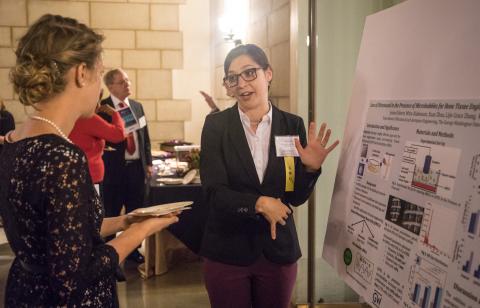With an increasing incidence of bone disorders in an aging population, engineered bone tissues may be a better alternative for conventional bone grafts. The challenge for bone tissue engineering is to form mechanically strong porous structures that can be grown quickly. Jenna’s research in Mechanical and Aerospace Engineering at the George Washington University (GWU) is in tissue engineering and acoustics. Jenna studies osteogenic differentiation of mesenchymal stem cells in 3D printed tissue scaffolds, utilizing microbubbles and nanodroplets with ultrasound to improve bone/cartilage regeneration. Her work uses lipid-coated microbubbles (MB), traditionally used for contrast enhanced ultrasound imaging, in order to determine the effects of ultrasound stimulation on proliferation and osteogenic differentiation of human mesenchymal stem cells (hMSCs) on 3D printed poly(lactic acid) (PLA) scaffolds. A significant increase in bone cell number, and osteogenic and chondrogenic differentiation was observed with low intensity pulsed ultrasound (LIPUS) treatment in the presence of microbubbles after 1, 3, and 5 days of culture on scaffolds. Collagen type II production increased 78% with ultrasound in the presence of microbubbles at a very high level of statistical significance when compared to non-treatment control cells. By combining low intensity pulsed ultrasound in the presence of microbubbles may provide a new technology for bone tissue engineering and regeneration therapies and was awarded one of the GWU Innovation & Entrepreneurship Winners for 2017. Jenna’s work entitled “Ultrasound and lipid-coated microbubbles for osteogenic differentiation of mesenchymal stem cells in 3D printed tissue scaffolds “was recently published in the October 2017 issue of the Journal of the Acoustical Society of America Volume 142(4) pages 2628-262, as well as presented at the 2017 GW Research Days Conference.

